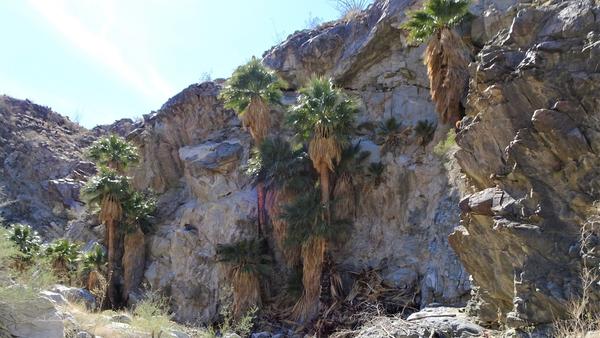Deserts get no respect
"I don't get no respect!" — Rodney Dangerfield
Rodney Dangerfield was a comedian popular on the television talk show circuit in the 1960s and 1970s. His self-effacing catchphrase was designed to elicit laughs, but it is also an unfortunately apt response to people’s perceptions of California’s deserts, and it is no laughing matter. California is by far the most biologically diverse of the United States’ contiguous 48 states; deserts comprise roughly one third of California’s land surface. Still, California’s deserts, as well as deserts world-wide, “get no respect” when it comes to their contribution to biodiversity.
The Oxford English Dictionary’s definition of deserts seems to sum up the prevailing anti-desert bias: “a large area of land that has very little water and very few plants growing on it." Other descriptors include “wasteland," “barren," and “lifeless." Desert is often used as a euphemism for a place where little or no life, food, or culture exists. Except for being arid, none of those perceptions holds any water. Nevertheless, these opinions persist, and seem to rationalize bad behavior that includes indiscriminate trash dumping, off-road vehicle “recreation," and profligate golf course development across otherwise undisturbed desert landscapes.
Let’s test the assumption or hypothesis that California Deserts are biologically depauperate. Covering one third of California, if species were randomly distributed, then we should expect about 33% of California’s plant and animal species to live in deserts. Values significantly less than 33% would support a belief that our deserts are, compared to elsewhere in California, lacking living things. On the other hand, if the percentages exceed 33%, then the assumption of our deserts being a barren wasteland would be categorically false.
While exact numbers will vary with shifting taxonomic whims, California is the home of almost 2300 native annual herbaceous plants, over 3600 native perennial herbaceous (not woody) plants, over 1300 species of native shrubs, and just under 240 native tree species (using Calflora’s Consortium of Herbaria database). Now, combining California’s three main deserts, the Great Basin, Mojave, and Colorado Deserts, along with the “sky island” mountains that are within or border those deserts, I found 55% of those native California annual herbaceous plants, 53% of perennial herbaceous plants, 60% species of shrubs, and 53% of those native tree species live in the California deserts. Of the three California deserts, the Mojave has the highest plant species richness, with 49% of those native annual herbaceous plants, 44% of perennial herbaceous plants, 52% of shrub species, and 45% of those native California tree species. Well above 33% of each of those plant categories; reject the hypothesis. In the categories of annual herbaceous plants and shrubs, California deserts have more species than any other ecological region in California. Our desert “wastelands” are not only richer from a vegetation standpoint, but they also appear to be incubators of speciation with many species occurring nowhere else on earth.
This pattern of species richness extends to other taxonomic groups as well. In a recently published study, Pillay et al. (2022, Frontiers in Ecology and the Environment, vol. 20, issue 1) looked at patterns of vertebrate animal species richness across our planet. Not surprisingly, they found that the tropics ranked number one, however, deserts were the next most species-rich biome when it came to mammals, birds, and reptiles, higher than temperate forests, shrublands and grasslands. Focusing back to California, reptile species richness is especially high in our deserts. Give or take one or two, California has 40 species of native lizards that call our state home. Ninety percent of those can be found in our deserts, again, well above the expected 33% if lizards were randomly distributed across California. At least six of those lizards are found nowhere else. Some areas are especially species rich. I, along with colleagues from the U.S. and Mexico, looked at lizard species richness across North America and found nowhere else compared to deserts in the number of species that occur together. And the top spot was the Coachella Valley at the edge of the Colorado and Mojave Deserts which has 33 lizard species within a 50-km radius circle. Of the 34 species of snakes found in California, 76% are found within desert habitats.
We do not have similar data sets for insects, but some insect families, such as darkling beetles (Tenebrionidae), specialize on living in arid habitats. Darkling beetles are the clean-up crews in deserts, technically detritivores, they eat dead things, replacing the job fungi and bacteria do in moist environments. Several years ago, I conducted a survey of darkling beetles living on the remaining sand dunes of the Coachella Valley. Across those dune fragments I found 34 different darkling beetle species. Try to put that into perspective; imagine finding a lake with 34 resident species of ducks, or a forest with 34 species of warblers, or a mountain range with 34 species of deer.
Beyond biodiversity, people also put value on superlatives such as the antiquity of individual plants or animals. In the Pacific northwest redwood trees can reach the old age of 3,200 years. In the central Sierra Nevada Range, giant sequoias can reach 2,700 years old, and in the White Mountains, bristlecone pines can be up to 4,800 years old. Impressive. But even more impressive is the oldest creosote bush, the most widely distributed desert shrub. The King Clone creosote is 11,700 years old. Take that for a superlative. Then there are desert tortoises who can approach nearly 100 years of age.
I have also heard deserts being demeaned because they lack the vibrant greens of temperate forests. My son countered that by saying our deserts are a kaleidoscope of beige and tan and brown. Within that kaleidoscope there is life with a richness that finds few if any challengers, short of the tropics. There is also unparalleled beauty.
Nullius in verba
Go outside, tip your hat to a chuckwalla (and a cactus), think like a mountain, and be safe.
